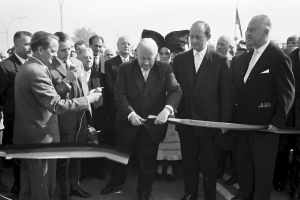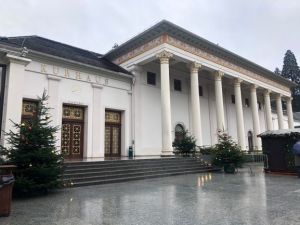Bas:Pont de l'Europe, Kehl, Baden Baden (0021FN0005)
Résumé
Contexte et analyse
In this short amateur film, Gilbert Breesé from Strasbourg documented an excursion to Baden-Baden with his wife in 1961. On the way there they make a stop in Kehl, where the Europabrücke was opened shortly before. The first few seconds show how Ms. Breesé walks across the Europabrücke in a summer dress. In addition, the train station and a crossroad are shown in Kehl. This is followed by pictures from Baden-Baden and its sights, in which the Breesé couple can be seen alternately in the picture. The pictures were shot with a 9.5 mm camera from Charles Pathé, whose technology was launched in France in 1922. The perforation is located in the middle between the individual images instead of on the sides, so that the entire width of the film could be used. The 9.5 mm film was flame-retardant compared to the common nitro film, which increased safety for the user.
There had been a bridge over the Rhine connecting Strasburg and Kehl since 1388. The bridge was called the 'Lange Bruck' and was destroyed and rebuilt several times. It was only in 1897 that it was replaced by the first modern road bridge on the Upper Rhine. After the First World War, the entire structure passed into the possession of the state of France in accordance with the Versailles Treaty. French troops blew up the western river pillar on October 12, 1939. In November 1944, German troops blew up two other river pillars. In April 1945, French pioneer units built a pontoon bridge, which was later replaced by a wooden bridge. The completely missing railing was a security risk. That's why cars kept falling into the Rhine from time to time. The bridge was seriously damaged after only three years because fresh wood had been used. For these reasons, the construction of a new bridge between France and Germany was contractually agreed on April 2nd, 1951. Germany alone took over the costs of DM 6.5 million. On September 23, 1960 the bridge was inaugurated as a symbol of European unification with the name Bridge of Europe, a symbol of Franco-German reconciliation and for Europe growing together.
The Breesés can be traveled from Kehl to Baden-Baden by car, bus or train. Since the first sequence shows the old city train station in Baden-Oos, they probably took the bus or train. On the back of the hotel directory from 1961 is a map with the most diverse sights of the city. The unanimous sequence in Baden-Baden shows exactly these motifs. The Breesé couple seems to have followed this map when walking through the city. The film shows the monastery school from the Holy Sepulcher, which was opened in 1670. After being destroyed by French troops, the sisters did not return to the monastery until 1700 because the church had been preserved. After a turbulent history, it was recognized by the state as a grammar school in 1952. Since 1968 it has been a high school with a mathematical and scientific focus.
In the spa town, the need for entertainment rooms and suitable bathing facilities grew at an early stage. As early as 1765, a promenade house was built, which soon no longer met the requirements. Today's Kurhaus consists of a casino, event rooms and a restaurant and was designed by Friedrich Weinbrenner. Large events always took place in the Kurhaus, such as the 1961 Miss Germany election or a sewing competition "Who sews won" for amateur dressmakers. The drinking hall is located right next to the Kurhaus, where the thermal water from the Friedrichsquelle and Nürtingen Heinrichsquelle is served during drinking cures. It was built in 1839-1842 and is still in the spa garden. The drinking hall is an open convertible hall with 14 murals that depict scenes from myths and legends as well as excursion destinations in the surrounding area. Behind the drinking hall there is a footpath to Michaelsberg and the Stourdza chapel. This is a tomb chapel that Prince Mihail Stourdza built for his late son Michael. His family preferred to stay in Baden-Baden in the summer. In 1866 the prince was appointed the 17th honorary citizen of Baden-Baden. The chapel still serves as the Romanian Orthodox Church.
In the film you can see Gilbert Breesé descending the stairs directly at the Josefinenbrunnen. It is therefore clear that they have visited the patronage facility. The patronage system is a public garden in the neo-baroque style after 1900. The Josefinenbrunnen is the central element of the complex. It was designed by the Munich sculptor Joseph Flossmann. The figures of the fountain are personifications of the drinking cure and the spa cure. You can also see a building of the Südwestfunk (SWF) for a short time. From 1946 to 1998 it was the public broadcaster for Baden and Rhineland-Palatinate. In 1998 the company merged with the Süddeutscher Rundfunk (SDR) to form the new Südwestrundfunk (SWR) station. The headquarters of the SWF was Baden-Baden, from there radio and television programs were broadcast.
Jessica Soares, Kristina SchwandtLieux ou monuments
Bibliographie
- ↑ Cette fiche est en cours de rédaction. À ce titre elle peut être inachevée et contenir des erreurs.








